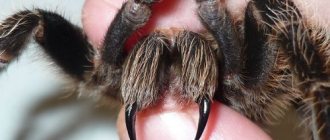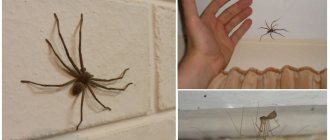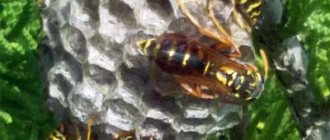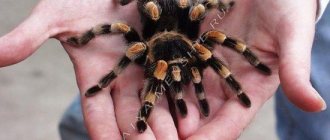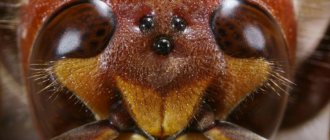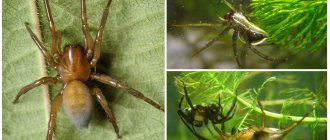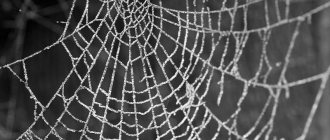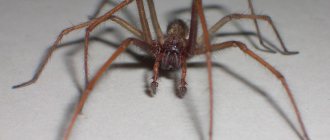There is a myth that house spiders become more active in winter, but in fact the opposite is true. The myth is that spiders move into houses to escape the cold or to find food. However, since spiders do not need to maintain body temperature like warm- and cold-blooded animals, they do not need to hide in warm places or hunt insects for food much because spiders can hibernate, which reduces their energy expenditure. Thus, spiders can live without food for months.
Winter does not affect the number of fruit flies, midges, carpet beetles, moths and silverfish in our homes, so even a starved spider waking up from hibernation has the opportunity to survive. House spiders can also feed on their relatives. That is why there are usually no more than three eight-legged neighbors in one house. They can also migrate in a critical situation. If there is absolutely no food, and the spider needs it, it can move either to another part of the house, or outside, to another house.
The only problem for house spiders is the danger of their offspring freezing. Nests often die due to excessive cold. However, spiders often find a solution to this problem using a unique form of web. They can turn it from a trap into a protective cover that will insulate the spiders that have not yet hatched.
According to their external features, spiders are classified as arthropods, just like crustaceans and insects. In the next gradation, the class of arachnids, spiders are the most numerous order. In addition to them, arachnids include about 10 more orders, including scorpions, ticks, and haymakers. Spiders are widespread everywhere, except on eternal ice. How do spiders living in harsh climate zones winter?
Who hibernates?
Hibernation is a very interesting and complex process that deserves our attention and observation.
Animals that mostly live in a temperate climate (warm summers and cold winters) go into hibernation. For many animals, hibernation is the only way to survive during the frosty winter, since at this time it is very difficult for them to get food for themselves. During hibernation (or hibernation), the animal's vital processes and metabolism, as well as its pulse and breathing rate, slow down. The animal begins to prepare for hibernation several months before the onset of cold weather. Before hibernation, it accumulates fat in order to survive this difficult period.
There is also torpor and suspended animation, characterized by more sound sleep and an even greater slowdown of internal processes.
In first place in this ranking is, of course, the well-known bear. However, it turns out that only three species of bears hibernate (brown, black and Himalayan). The rest of the bears (including polar bears) do not hibernate.
A bear's sleep is not as sound as that of other hibernating animals. The bear sleeps lightly and superficially. The body temperature practically does not decrease, and all internal processes work in the usual rhythm. However, waking up a hibernating bear is highly discouraged. An awakened bear is very aggressive, angry and dangerous. Often a bear simply wanders through the forest, using up its accumulated energy before winter and losing its fat reserves. Such bears are called “connecting rods”.
During hibernation, a bear can lose up to half its body weight.
2. Hedgehog.
Hedgehogs do not store supplies for the winter, as they feed mainly on insects. Therefore, they have to store fat in the summer season and sleep in the winter. By winter (in October), hedgehogs become fat and hibernate, finding refuge in dense bushes, depressions in the soil, covered with fallen leaves, among forest brushwood. The hedgehog wakes up only when the frost stops.
3. Gopher.
Gophers are animals that can hibernate for a very long time, up to 9 months a year. After awakening, they most often experience a short period of vigorous activity.
Not all bats hibernate. This directly depends on the climate and habitat. If temperatures in a bat's habitat fall below freezing in winter, they either hibernate in caves or other sheltered areas or migrate to warmer areas. Hibernation resembles deep sleep, in which the heartbeat is barely noticeable and breathing slows down to one inhalation and exhalation every 5 minutes. An active animal's body temperature is 37-40°C, but during hibernation it drops to 5°C.
5. Marmot.
All marmots, regardless of species, hibernate.
Research has shown that marmots prefer plants rich in polyunsaturated fatty acids, the higher concentration of which in the fatty tissue of sleeping animals helps them tolerate lower temperatures during hibernation. By the end of summer, marmots accumulate up to 800-1200 g of fat, which amounts to 20-25% of their weight. During hibernation, the life processes of marmots almost freeze: body temperature drops from 36-38 to 4.6-7.6 °C, breathing slows down to 2-3 breaths per minute instead of the normal 20-24, and heartbeat - to 3-15 beats per minute instead of 88-140. In winter, marmots do not eat and hardly move, subsisting on stored fat reserves. However, since energy expenditure during hibernation is low, in the spring marmots often wake up quite well-fed, with a reserve of 100-200 g of fat.
During the winter, badgers go to sleep. Just like in bears, it is almost not accompanied by a decrease in body temperature and a slowdown in basic vital functions. By autumn, the badger accumulates significant reserves of subcutaneous fat, so that its weight almost doubles. By the time it lies down, its hole has already been cleaned, the nesting chamber is filled with fresh bedding, and the badger, climbing into the hole for the last time, clogs the entrance holes with earth and leaves. If several animals live in one common “badger” for the winter, then each one sleeps in a separate nesting chamber. Animals stop appearing on the surface after the first snow falls. In the spring, they awaken with the beginning of active snow melting, when the average daily temperature passes zero.
Where do spiders go and how do they spend the winter? Feeding and wintering habits of arthropods
According to their external features, spiders are classified as arthropods, just like crustaceans and insects. In the next gradation, the class of arachnids, spiders are the most numerous order. In addition to them, arachnids include about 10 more orders, including scorpions, ticks, and haymakers. Spiders are widespread everywhere, except on eternal ice. How do spiders living in harsh climate zones winter?
Where do spiders go in winter?
Arthropods adapt to the onset of cold weather in different ways. Spiders are unable to tolerate temperatures below 0 degrees due to tissue crystallization. Depending on this, spiders can sleep or die in winter.
Young cross spiders and “newborn” wasp spiders migrate on wind-blown spider webs in search of habitat on warm September days. Huddled in a crack in the bark of a tree, spiders sleep in winter.
Sexually mature parents of baby wasps end their life in the summer: the male - in the form of a “wife” dinner after mating, the female - after laying eggs. A similar situation occurs in adult crosses. Autumn is the mating season, when males go in search of females sitting in their web. After fertilization of the female, the male dies. The spider weaves a cocoon in which it lays eggs. Having hidden it in a secluded place (in the bark of trees, cracks in masonry), it also dies. In the spring, spiderlings emerge from the eggs, ready to weave webs.
Males and females of black widows do not survive until the cold weather. At the end of June, mating occurs, after which the female eats the “suitor”. Having laid up to 130 eggs in prepared cocoons, she hides them in lairs (mouse holes, crevices) entwined with dense cobwebs and dies. Spiders appear in September and live in a cocoon until April, eating each other. With the onset of stable heat, they go outside.
As for the species of black widows, spiders that were born in September spend the winter with them. In a warm cocoon left by a caring spider mother, they sleep until April. Spreading in search of habitats, they have arachnoid and venom-carrying apparatus. During mating at the end of June, the female karakurt eats the male. After laying eggs it dies.
Domestic arthropods may go into torpor with the onset of winter if the number of indoor parasites decreases sharply. Waking up before the onset of spring, they can feed on their relatives.
Rare species live in burrows and crevices
Predatory arthropods, whose life cycle exceeds a year, fall into torpor with the onset of cold weather. Species such as tarantulas live in the wild for 5 to 10 years. Helping them survive is the ability to go without food for a long time and the mild climate in their habitats. With the onset of cold weather, they burrow into their vertical burrows and hibernate until spring.
The edge hunter has a life expectancy of 2 years, until the age of mating. After breeding, they die in August. Immature individuals spend two winters in the mother's cocoon, attached to the grass on the shore, in a state of torpor.
Silverback spiders build their winter cocoons underwater
During the cold season, when rivers and lakes are frozen, the silverfish prepares winter housing. The spider controls the volume of the bell and the oxygen content in it. The air supply in such a cocoon is enough for 4-5 months. Nearby, the silverfish weaves the second and third mesh networks and fills them with air. This insurance allows you to overwinter without rising to the surface until warm days arrive.
Hiding in a mollusk shell
If there is no algae and nowhere to go, the water spider can use an abandoned mollusk shell instead of a cocoon. He fills it with air bubbles from the surface and covers it with thick nets instead of curtains. Such a house serves as reliable protection from large fish and crayfish.
They overwinter with young offspring (the female is eaten in the spring)
The black fathead spends its winter in a special way. With the onset of autumn, the mating period approaches, and the males go in search of females. Having carried out the necessary fertilization ritual, the male remains to live in the same burrow with the female. The fathead spider makes a cocoon for its offspring, where it soon lays eggs.
For 2 months, spiders guard the clutch in a cocoon. With the onset of spring, spiders appear. Spiders serve as food for them. By the end of summer there are 3 molts. Young spiders crawl out of their holes to find a home. After 2 moults they will become sexually mature and will look for a female. A male spider, whose life cycle is less than a year, dies by this time.
What do they eat in winter?
Most spiders cannot eat their food right away. The venomous bite is necessary to paralyze the victim and turn its insides into a nutritional cocktail. The peculiarity of spider physiology does not require maintaining a constant temperature. For this reason, they can go without food for a long time and fall asleep, falling into torpor. During the winter months, the food supply is maintained by water and house spiders.
What do house spiders eat in an apartment in winter? Flies and mosquitoes stop penetrating into human housing with the onset of cold weather, going into hibernation. But apartments can be inhabited by cockroaches, moths, and fruit flies. Predators eat each other, thus redistributing habitat areas. The life cycle of house spiders is short: from 2 to 6 months. Reproduction depends on the food supply: if it is insufficient, new offspring appear after the end of the life cycle of the parents.
Preparations for the winter
House spiders, which do not hibernate in winter, surprise with their activity. What can spiders eat in an apartment in winter? If you look closely at the nets they spread, you can see the remains of insects wrapped in webs. The predator prudently creates “storerooms” in cool, damp places, where they can be stored longer without drying out. If there is a “raw material base”, spider stocks are renewed throughout the cold period. The spider withstands long breaks in feeding, supporting itself with water and ceasing active movements.
Source: https://dezplan.ru/vopros/kak-zimuyut-pauki
Spiders sleep in winter
Most spiders have a lifespan of less than one year. In cold weather, spiders usually die because they cannot live in such a climate. However, some types of insects are able to survive even winter. Thus, most spiders hibernate during the winter. But there are also exceptions.
Such exceptions include the South Russian tarantula. This type of winter spider crawls into its burrow and clogs the entrance with earth. The spider crawls out of its home only when it wants to eat. If the South Russian tarantula gets into a warm room next to a person’s home, then it can lead a normal life all winter. But this behavior is typical only for the South Russian tarantula. All other spiders that endure winter climb into their burrows at this time and fall asleep until the onset of warm seasons.
Where do mosquitoes, midges and midges go in winter?
When cold weather sets in, many animals go into survival mode. We humans have been able to remake the environment quite well for ourselves. We settle into houses, turn on the heating and eat fresh food bought in stores.
Animals have completely different living conditions. Both food and shelter are difficult to find in winter, so they have to use different survival tactics. Some mammals hibernate. Birds sometimes fly south in winter. But where do the little crawling creatures go? Where do insects spend the winter?
Where do insects live?
Typically, breeding and resting sites indicate what insects do in winter. The most interesting in this regard for homeowners, of course, are blood-sucking insects, especially mosquitoes. They should be given special attention.
- Mosquitoes rest in tall grass, bushes and weeds. They breed in shallow bodies of standing water, including birdbaths, outdoor decorations where water can accumulate, and even in gutters.
- Midges have a wider range and can live on beaches, ponds, streams and wetlands. They can reproduce in any amount of water.
- Midges live near running water, including streams and rivers. They lay eggs in the water and the larvae attach to rocks at the bottom before becoming adults.
Believe it or not, all these pests use the same winter shelters. How do they do it? Read below!
How do insects survive in icy water?
Regardless of the temperature, mosquitoes, midges and midges, along with their eggs and larvae, are always somewhere nearby.
In winter they are not visible, but their eggs cling to life and wait for the return of warm days. Eggs and larvae rarely freeze to death. They attach themselves to plants or become buried in the mud at the bottom of streams, lakes, rivers and other water sources.
Yes, it is cold in winter, but this is not enough for such creatures. Even on the coldest days, only the top layer of rivers, ponds and lakes freezes. As a result, insect eggs and larvae have developed the ability to survive in a layer of water that rarely freezes.
During long cold spells, these insects lurk and wait. When temperatures rise in the spring, they simply continue their development from egg (or larva) to adult.
How do insects survive winter?
Insects have several methods to survive the cold, and each species chooses its own option. Some butterflies, for example, migrate south to warm weather and abundant food. Bees stay warm by gathering together in their hive.
What about mosquitoes, midges and midges? How do they survive the winter? They use the same methods as other insects, namely:
- Diapause is a suspension of development. Diapause allows midge and midge larvae to slow down their metabolism to cope with cold temperatures.
- Frost protection . This protection allows insects to survive the cold using biochemical processes. The water in the body of some species of mosquitoes is replaced by glycerol, which allows them not to suffer from low temperatures. Glycerol is a natural antifreeze.
- Natural shelter . Some insects, including female mosquitoes, enter diapause and find shelter. Burrows, hollows and other protected places are suitable for the latter. Less “natural” shelters can be cracks in houses, cellars, basements, attics and garages.
- Step by step hatching of eggs . The eggs and larvae of some insects use a method of protection from freezing along with natural shelter. The insects lay their eggs in places protected from the cold, and the eggs extend their incubation period until warmth returns. When the cold weather ends, the eggs are ready to give birth to a new generation.
Victory over blood-sucking insects
Insects can survive even the harshest winters, so you need to prepare in advance for their awakening in the spring. You can spray lethal chemicals around the house or use a more effective method - a gas trap. Such traps are safe for the environment; they attract and destroy only blood-sucking insects.
Destructor traps from Mosquito Magnet operate using Counterflow Technology. With its help you can significantly reduce the number of bloodsuckers in your area. This way you can protect yourself, your family, pets and guests from all the blood-sucking insects during mosquito season.
In addition, an insect bite can pose a real danger. Not only can it cause severe allergies, but it can also become a source of infection with dangerous diseases. This is how malaria, West Nile fever, Dengue fever, various encephalitis, Zika fever, Mayaro fever and Chikungunya are transmitted. Each of these diseases can have fatal complications. If you choose a method of protection against mosquitoes and other blood-sucking insects, it is better to consider those that have proven effectiveness.
Mosquitoes in winter?
Our battle with blood-sucking mosquitoes is only briefly interrupted in winter, but never stops. The temperature drops, snow and ice appear, but the eggs of mosquitoes, midges and midges wait in the wings under a layer of ice or in relatively warm shelters. As soon as spring comes, these insects return again.
If you have any questions about how to protect yourself from blood-sucking insects, you can ask your questions using the form on the website or call 8 (800) 5555-145. And also in our Knowledge Center there is a lot of useful information about mosquitoes, vector-borne diseases, how traps work and much more.
If you are interested in traps from the Mosquito Magnet company, you can choose a mosquito killer that is suitable for you in our catalog.
Source: https://mosquitomagnet.spb.ru/stati/kuda-devayutsya-komary-moshki-i-mokrecy-zimoy/
What do spiders eat in the winter?
The South Russian tarantula, silver spider and Eresus cinnaberinus do not hibernate. The South Russian tarantula can lead an active lifestyle in winter, being in a warm room near human habitation. In these places there are enough insects necessary to feed the South Russian tarantula.
Wintering of silver spiders is a very interesting phenomenon. For the winter, these spiders make cocoons underwater, into which they hibernate. Sometimes they overwinter in empty mollusk shells. Having found such a shell, the spider forces air into it until it floats to the surface. The shell is attached by spider threads to aquatic plants (duckweed) floating on the surface. The spider hides in the shell and closes its opening with plant debris held together by cobwebs.
How do spiders live in winter?
Most spiders have a lifespan of less than one year. In cold weather, spiders usually die because they cannot live in such a climate. However, some types of insects are able to survive even winter. Thus, most spiders hibernate during the winter. But there are also exceptions.
Such exceptions include the South Russian tarantula. This type of winter spider crawls into its burrow and clogs the entrance with earth. The spider crawls out of its home only when it wants to eat. If the South Russian tarantula gets into a warm room next to a person’s home, then it can lead a normal life all winter. But this behavior is typical only for the South Russian tarantula. All other spiders that endure winter climb into their burrows at this time and fall asleep until the onset of warm seasons.
What do spiders eat in the winter?
The South Russian tarantula, silver spider and Eresus cinnaberinus do not hibernate. The South Russian tarantula can lead an active lifestyle in winter, being in a warm room near human habitation. In these places there are enough insects necessary to feed the South Russian tarantula.
Wintering of silver spiders is a very interesting phenomenon. For the winter, these spiders make cocoons underwater, into which they hibernate. Sometimes they overwinter in empty mollusk shells. Having found such a shell, the spider forces air into it until it floats to the surface. The shell is attached by spider threads to aquatic plants (duckweed) floating on the surface. The spider hides in the shell and closes its opening with plant debris held together by cobwebs.
Where do spiders come from in apartments in winter?
Spiders often appear in an apartment or house in winter. People wonder where spiders can come from in winter if they all hibernate at this time. There are many options for where spiders come from at this time. One of the most important options is normal living conditions for spiders.
The second option is that cocoons with spider eggs can remain in any crack, in the floor or under a chair. Spider children emerge from this cocoon. This can happen after renovation or general cleaning. These spiders can crawl all over the room. They can be easily destroyed using conventional disinfestation sprays, such as dichlorvos. In addition to this, all cobwebs should be removed from the house and burned. It is also worth sealing the cracks in the baseboard with silicone. You should also use insect repellent chalk to deprive spiders of food.
Preparations for the winter
House spiders, which do not hibernate in winter, surprise with their activity. What can spiders eat in an apartment in winter? If you look closely at the nets they spread, you can see the remains of insects wrapped in webs. The predator prudently creates “storerooms” in cool, damp places, where they can be stored longer without drying out. If there is a “raw material base”, spider stocks are renewed throughout the cold period. The spider withstands long breaks in feeding, supporting itself with water and ceasing active movements.
Sources:
https://dezplan.ru/vopros/kak-zimuyut-pauki https://www.kakprosto.ru/kak-895941-otkuda-berutsya-zimoy-pauki https://ruspoll.ru/drugie-vrediteli/chto- edjat-pauki-v-kvartire-v-domashnih-uslovijah.html

